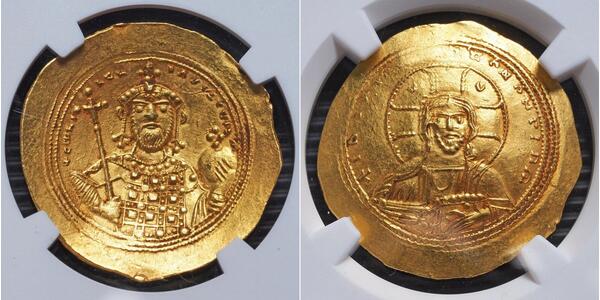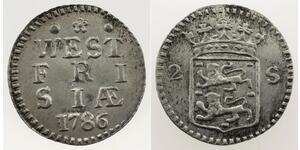1 Histamenon
1042, Byzantine Empire, Constantine IX. Gold Histamenon Nomisma Coin. NGC Choice AU 4/3!
Mint Period: 1042-1055
Mint Place: Constantinople
Emperor: Constantine IX Monomachus
Denomination: Gold Histamenon Nomisma
References: Friedberg 249, DOC 3, SB 1830.
Condition: Certified and graded by NGC as Choice AU 4/3!
Diameter: 28mm
Weight: 4.43gm
Material: Gold!
Obverse: Crowned facing bust of Constantine, holding long cross and globus cruciger.
Legend: + CWHS-T-Atn - bASILEUS
Reverse: Facing bust of Christ Pantokrator.
Legend:
+ IhS XIS REX REGNANTInM
In Christian iconography, Christ Pantocrator (Greek: Χριστὸς Παντοκράτωρ) is a specific depiction of Christ. Pantocrator or Pantokrator, literally ruler of all, but usually translated as "Almighty" or "all-powerful", is derived from one of many names of God in Judaism. The Pantokrator is largely an Eastern Orthodox or Eastern Catholic theological conception and is less common under that name in Latin Catholicism. In the West, the equivalent image in art is known as Christ in Majesty, which developed a rather different iconography. Christ Pantocrator has come to suggest Christ as a mild but stern, all-powerful judge of humanity. When the Hebrew Bible was translated into Greek as the Septuagint, Pantokrator was used both for YHWH Sabaoth (צבאות) "Lord of Hosts" and for El Shaddai "God Almighty". In the New Testament, Pantokrator is used once by Paul (2 Cor 6:18) and nine times in the Book of Revelation: 1:8, 4:8, 11:17, 15:3, 16:7, 16:14, 19:6, 19:15, and 21:22. The references to God the Father and God the Son in Revelation are at times interchangeable, but Pantokrator appears to be reserved for the Father except, perhaps, in 1:8.
Constantine IX Monomachos (Medieval Greek: Κωνσταντῖνος Μονομάχος, romanized: Kōnstantinos IX Monomachos; c. 980/c. 1000– 11 January 1055) reigned as Byzantine emperor from June 1042 to January 1055. Empress Zoë Porphyrogenita chose him as a husband and co-emperor in 1042, although he had been exiled for conspiring against her previous husband, Emperor Michael IV the Paphlagonian. The couple shared the throne with Zoë's sister Theodora Porphyrogenita. Zoë died in 1050, and Constantine continued his collaboration with Theodora until his own death five years later.
Constantine waged wars against groups which included the Kievan Rus', the Pechenegs and, in the East, the rising Seljuq Turks. Despite the varying success of these campaigns, the Byzantine Empire largely retained the borders established after the conquests of Basil II (r. 976–1025), even expanding eastwards when Constantine annexed the wealthy Armenian kingdom of Ani. Constantine accordingly may be considered the last effective emperor during the Macedonian Renaissance.
In 1054, a year before Constantine's death, the Great Schism between the Eastern Orthodox and Roman Catholic Churches took place, culminating in Pope Leo IX excommunicating the Patriarch Michael Keroularios. Constantine, aware of the political and religious consequences of such a disunion, made unsuccessful efforts to prevent the breach.

|
发布人:
anonymous 2024-07-23 |
|
||
|
||
|
||
|
||
|
||
2 Stuiver 荷兰 銀
本组有 33 钱币 / 33 售价
⇑




 Deutsch
Deutsch Русский
Русский Українська
Українська English
English Italiano
Italiano Français
Français Español
Español 汉语
汉语












